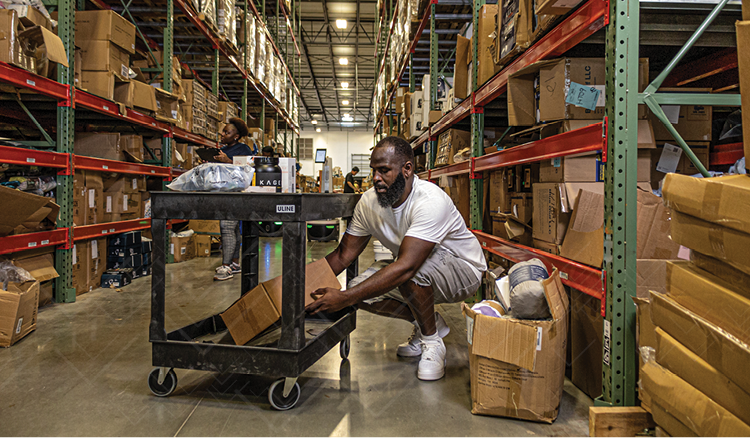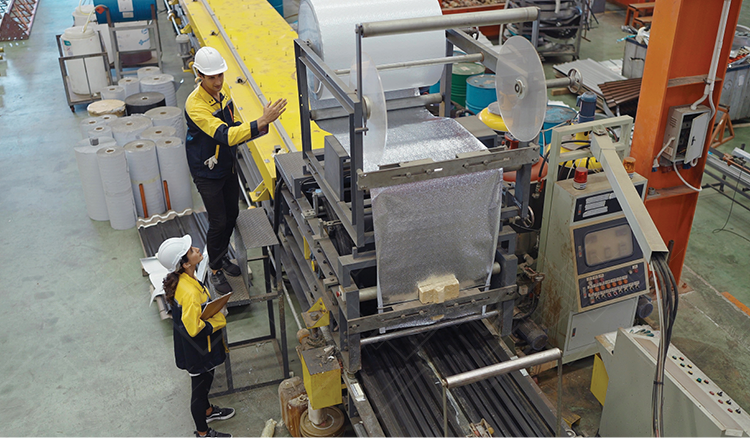The Amazon Effect on Manufacturing and How to Adapt
There are three words that scare operations managers everywhere: free two-day delivery. This phrase wraps up the Amazon effect and slaps a bow on it. Customers are starting to expect reliable on-time delivery of whatever goods they want with little extra cost, and they’re expecting it to happen faster than ever before.
If you’re in manufacturing or logistics, you’ve likely felt the burn from the Amazon effect. It often shows itself in conversations with customers. They express their expectations for the level of service Amazon provides, and you’re standing there tied in a knot.
The problem with these expectations is that your company isn’t Amazon. Maybe you’ve missed your chance to gain extra revenue because of these expectations. Maybe the line graph showing your company’s market share has flattened or declined.
So how do you delight your customers in the face of these incredible new expectations?
Veryable works with manufacturing and logistics leaders who are feeling the Amazon effect every day. We provide an on-demand labor platform to connect businesses to workers, so they can decrease their lead times and meet the extra demand created by their speed.
Adding workers is just one solution for adapting to the Amazon effect. We zoomed out to get a look at the bigger picture, and we’re sharing what we found so your business can stay competitive whether you choose on-demand labor or not.
By the end of this article, you will know how to adapt to strict customer expectations of fast delivery by following four simple steps.
How to adapt to the Amazon effect in manufacturing
- Define your existing advantages
- Shorten your cycle times
- Reduce your lead times
- Improve your on-time delivery rate
- Continue to watch cycle times, lead times, and on-time delivery rate
Step 1: Define your existing advantages
You are still in business because your company provides some value to your customers that they don’t see in your competitors. It is important to identify what this value is and embrace your strengths so that you can emphasize these to customers and prospects.
Being aware of your limitations and strengths is the first step toward improving your business. Gaining a competitive advantage is easier when you play to your strengths. Until you can finish the steps below, defining why your products and service levels are superior in some way to your competitors’ will go a long way in reminding prospects and customers that you are still in the game.
Your advantage might be that you are local, in which case you can relay this in your company’s communications through a tagline or in small ways on letterheads and invoices. You could run a special that rewards other local companies for choosing your business. This is just one example of an advantage you could showcase, but whatever your advantage is, it is up to you to communicate this to your prospects and customers in words and in action.
Step 2: Shorten your cycle times
When all else fails, fight fire with fire. If the name of the game is speed, then you should be finding a way to speed up your company’s processes.
After identifying your strengths, you’re ready to shorten cycle times as a first step to competing with two-day shipping. A cycle time is the time a product spends in production. This excludes the inbound and inventory stages.
Shorter cycle times create a buffer for your lead times. Since your cycle time is a part of your overall lead time, when you shorten your cycle time you can shorten your lead time. This enables you to reach a higher on-time delivery rate because you have more time to handle unexpected hangups. Or, you can shorten the lead times you promise your customer to compete directly with two-day shipping.
For example, if you could get your cycle times to be one third of your lead times, you could complete orders with time to spare. You could easily wait and ship the order just in time because you finished production so early, or you could ship it faster than you would have before to delight your customers. If you decide to ship just in time, you can save money because you aren’t forced to pay for expedited shipping.
One way to shorten cycle times is to make your production process more efficient. You can do this by removing bottlenecks. To get rid of bottlenecks, measure the output of each step of your production process, then identify any step that is producing at a slower pace than the step before it. This is your bottleneck. If you can change this step to increase its output without increasing the labor needed, you can increase its efficiency and remove the bottleneck. Maybe this means buying more machinery, or if a machine is not creating the bottleneck, the labor-dependent process might have room for improvement.
If you cannot remove your bottleneck, the other way to shorten cycle times is to ensure you do not starve your bottleneck. Starving your bottleneck is when you don’t have enough units moving into the bottleneck so that it is always running. Since there will almost always be a bottleneck, you need to know how to work through them.
When the step before your bottleneck is labor-intensive, the easiest way to feed your bottleneck is to add more workers to that step. With the extra output, you’ll be able to keep enough units waiting to enter the bottleneck that you have a buffer. Many businesses do not want to add workers to increase throughput because they see that it would cost them more. However, in some cases, the costs are outweighed by the increase in throughput and resulting profits.
Imagine being able to take on additional orders which you would typically have turned down because now your cycle times are so much shorter than your lead times. How much more money could your business be making, and how does that compare to the cost of additional workers?
Shortening your cycle times will give you the wiggle room you need to take the next steps toward beating the Amazon effect, and the step might result in additional revenue opportunities just by itself.
Step 3: Reduce your lead times
Shorter lead times directly compete with Amazon and the expectations created by two-day delivery. If your cycle times are already as short as you can make them, you are ready to reduce your lead time.
To reduce your lead times, you have to minimize the time the product spends between when it is a raw material and when it’s loaded onto a truck. Shortening cycle times affects the middle of your lead time, where the production process happens. That leaves the remaining steps of speeding up order processing, material acquisition, unloading, inventory, packaging, and loading processes.
The methods for improving lead time are mostly the same as those for improving cycle time. You can remove bottlenecks by optimizing each of the processes mentioned above, or you can add workers to increase your throughput.
Step 4: Improve your on-time delivery rate
By this point, most of the hard work is done. If you did step two and step three properly, this step almost takes care of itself.
With shorter cycle times and shortened lead times, you have options for how to maintain a high on-time delivery rate. You can promise and uphold faster delivery, or you can more consistently deliver on time at your current promised lead time.
If you know that your suppliers and logistics aren’t what’s slowing you down, you can communicate the changes you need from them to start delivering more quickly. Schedule more frequent unloading and pickups if you plan to promise faster delivery.
On the other hand, maybe it is your suppliers or logistics that are slowing you down. If they can’t come to your site any more frequently than they already do, it might be time to reconsider your relationship with them. With the extra revenue from faster lead times allowing you to take more orders, making the necessary changes and investments to improve your on-time delivery rate could be worth it.
Step 5: Continue to watch cycle times, lead times, and on-time delivery rate
The work isn’t finished after you make this one round of improvements. It’s safe to assume that Amazon won’t slow down any time soon, so neither should your business. Continue tracking your cycle times, lead times, and on-time delivery rate to ensure you stay on the right path of continual improvement.
Define what is an acceptable level of variation from these metrics throughout the year, and when a change occurs outside that range, investigate immediately.
Adding workers to increase throughput
If you aren’t able to reduce cycle times and lead times enough just by improving your processes, you can add workers to increase throughput. As mentioned in the steps above, extra workers can help solve problems that otherwise might be impossible to fix.
However, you’ve probably avoided this choice because finding more workers can be expensive and time-consuming, especially if you only need the extra hands for a short period of time.
With on-demand labor from Veryable, you can find workers when you need them without having to commit to hiring someone full-time. Read more about on-demand labor and how it can give you the flexibility you need to fill the extra orders you can take with shorter cycle times and lead times.
Previous Posts
How Policy Constraints, Not Just Production Bottlenecks, Threaten Your Bottom Line
The Future of Manufacturing and Logistics
Create a free business profile today to explore our platform.






